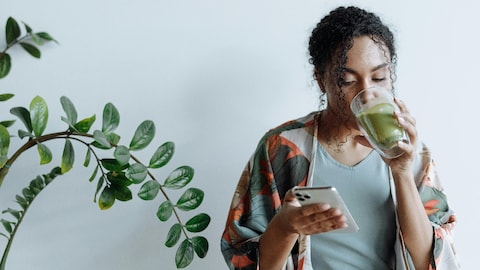Your matcha obsession might be messing with your health—here’s the tea
It’s the wellness queen of Instagram—but is your matcha habit secretly toxic?

We all loved matcha—and let’s be honest, we still do. From skincare and haircare to desserts and even savoury dishes, the green goddess infiltrated every corner of our lives like a surprise lead taking over the script. What started out as a trendy wellness drink quickly turned into a full-blown lifestyle flex. And somehow, we’re all still sipping the Kool-Aid (or should we say, latte?).
But like most great love stories, this one might have a dark side too. If your daily matcha ritual has started to feel less like a mindful moment and more like a compulsion, it may be time to take a closer look. Is this a healthy habit—or have we been greenwashed?
To help decode the obsession, we spoke to two nutrition pros: Dr Raksha Lulla, a consulting nutritionist at Locavore Consulting LLP, and Dr Poorvi Bhat Khandige, a nutritionist and founder of Herbeshwari, with an MSc in Nutrition from King’s College London. Together, they break down what’s fact, what’s hype, and when it might be time to slow your sip.
A genuine liking or a marketing gimmick?
What started as the ultimate “that girl” drink has quickly become a status symbol—a lifestyle marker shared through perfectly edited Instagram stories. But do we really like the taste of matcha, or are we simply caught up in the hype?
“I recently came across a very insightful post on Instagram. It explained how, when there’s global hype and a subsequent shortage of a particular ingredient, we tend to commodify it and start using its extract in everything else,” Dr Khandige says. “Matcha has become the ‘it’ ingredient of the moment, much like blueberries a few years ago or amla before that. Whenever a particular ingredient sees a global boom and limited supply, we tend to commodify it and start using its extract in everything. Eventually, people move on to the next antioxidant-packed hero.”
Lulla puts it even more bluntly, “Any ingredient like turmeric, moringa, or matcha starts gathering fame with populations who do less for themselves or believe they do less and hence need to outsource the responsibility of being taken care of to a single ingredient, with all due respect.”
When green turns into a red flag
Matcha’s vibrant hue was the hook—it pulled us in with aesthetic drinks like earth matcha lattes and strawberry matcha boba. For many, it sparked a full-blown obsession. But too much of anything, even something as photogenic as matcha, can be problematic. And overconsumption doesn’t just mean overindulgence—it can seriously mess with your sleep.
“Yes, matcha can trigger insomnia,” warns Khandige. “That’s because you're consuming the whole leaf, unlike green tea where you only drink the infusion. Matcha contains a significant amount of caffeine, so if you’re overdoing it, it can absolutely interfere with your sleep. For anyone prone to insomnia, I wouldn’t recommend consuming any caffeinated drink, including matcha, after 2 pm.”
The importance of cultural context and geographic relevance
We’ve all heard the saying: eat what grows around you. And when it comes to matcha, that advice is more relevant than ever.
“Historically, matcha wasn’t an everyday beverage,” says Khandige. “It originated as part of Buddhist rituals and later became central to the Japanese tea ceremony—an experience rooted deeply in mindfulness and intention. The emphasis was on the process, not just the drink itself.”
Today, matcha is often consumed iced, on the go, and sometimes multiple times a day—in volumes that weren’t part of its original context. “Modern consumption habits differ significantly from tradition. To truly benefit from matcha, it’s important to respect its origins and cultural significance,” she adds. Lulla agrees, with a gentle reminder: “Avoid matcha if it doesn’t grow locally or if the taste doesn’t sit well with you.” Both experts point out—what works beautifully in one culture or geography doesn’t need to be force-fit into another.
Iron absorption—the quiet struggle too many of us share
According to research by the National Institutes of Health, India has the largest population of anaemic individuals in the world—and the numbers are only rising. And believe it or not, your beloved matcha could be contributing to the issue.
“When matcha is paired with a meal, it can reduce iron absorption,” explains Lulla. “It contains catechins that bind to iron, making it harder for your body to absorb it. That’s why it should be consumed at least one hour apart from meals or medications.” She adds, “Indian genetics don’t necessarily resonate well with green tea or matcha—so in many cases, it can be avoided altogether.” That Sunday ritual of sipping matcha at your favourite café brunch? It might be time to rethink it—or at least check your iron levels before the next refill.
Maybe it’s time to break up?
Ask yourself—have you become a Joe Goldberg for matcha? Has it gone from being just a drink to your daily motivation? Do you find yourself obsessively trekking across town just to try that new matcha spot?
If yes, maybe it’s time to step back.
Because no matter how pretty or popular, toxic relationships tend to do more harm than good. And this time, the one getting hurt might be you.
Lead Image: pexels
Also read: How the gym became the internet’s favourite stage
Also read: What is sensehacking and can it really trick your brain into feeling happier?